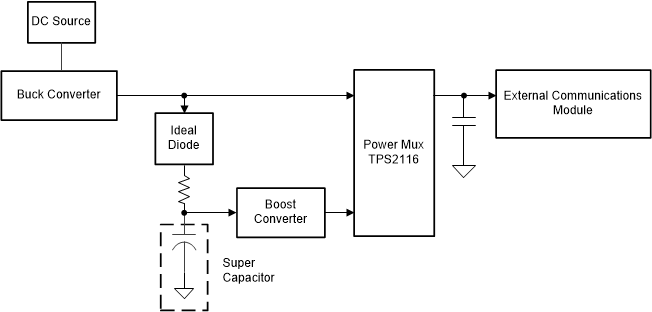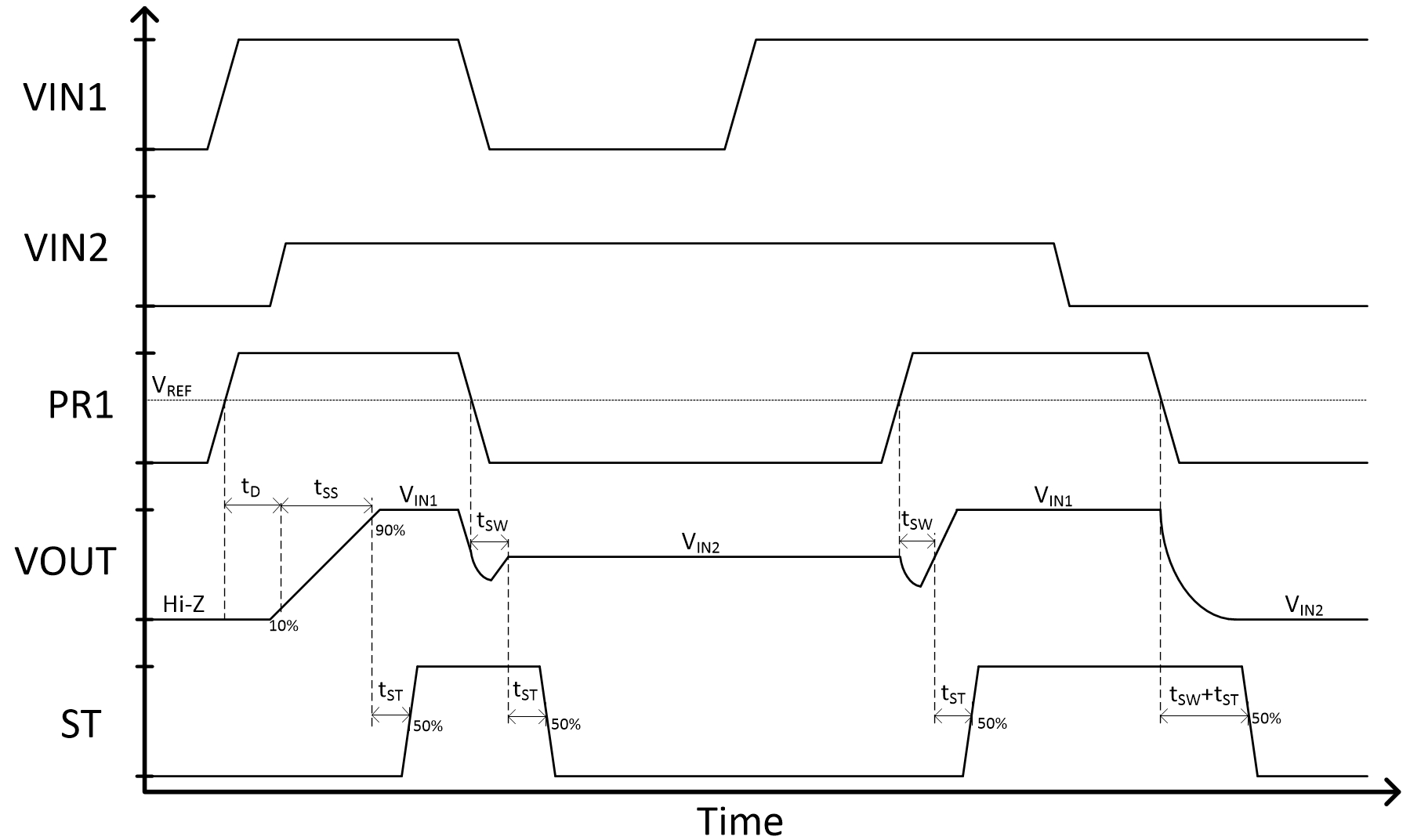SLVAF06 December 2020 TPS2116
Application Brief
As the demand for reliable power increases annually, accurate monitoring and reporting of electricity use and outages is a priority for any power distribution network. To meet this demand, electricity meters or eMeters have evolved from simple gauges to more involved solid state based devices. These “smart” eMeters offer advanced security and communication features that benefit both power distributors and consumers by providing an accurate representation and billing of the power demand. Due to the de-centralized nature of these systems, fault reporting is vital in the event of a failure or a power outage. Using a PowerMUX like TPS2116 in the power supply of an eMeter increases system robustness and reliability. The device integrates protection features like reverse current blocking and soft start capability with fast switchover from one power rail to another. Its fast switchover allows the system to provide a “last-gasp” report of the final readings and fault to the distributors with minimal voltage dip on the output.
Last Gasp Reporting
For last gasp reporting, two power sources are required; a main supply and a backup supply. In most eMeter systems, the only source of power is from the AC main line through an AC/DC converter. To provide backup power, batteries can be used as a secondary source but are difficult to integrate due to the need of a battery management system. Last gasp reporting is also not a long term operating state and so a bulk capacitor backup could be used instead. A system of two interlinked switches or diodes could be used to transition between the main supply and the backup capacitors. Figure 1-1 describes the implementation of a last gasp system in eMeters.
 Figure 1-1 Last Gasp Topology in eMeters with TPS2116.
Figure 1-1 Last Gasp Topology in eMeters with TPS2116. During normal operation, power is passed from the main supply to the output through main switch the while the other remains off. The main supply also provides the power to charge and maintain the voltage on the bulk capacitor. In the event of an unexpected loss of power or if a failure is reported to the controller, the switch connected to the backup bulk capacitor is turned on. The trigger for this transition could be through an external control signal or set to switch when the main supply drops below a certain voltage. The capacitor provides the power for a “last-gasp” report to the power distributor which contains the last complete packet of data and a failure code before the system shuts down safely.
Advantages of TPS2116 in eMeter Applications
Electronic meters perform their reporting structure through a communication module which communicates via GSM transmissions. Since the integrity of the signal is paramount, the module has a stringent set of operating conditions that has to be maintained during switchover. These conditions include but are not limited to; a tight operating voltage tolerance, instances of high current pulls such as that during transmission and large input capacitors to the order of a few thousand uF. Conventional topologies for MUXing include the use of diodes and MOSFETs to switch between power rails. The limitations of these topologies are brought to the forefront in eMeter applications.
The tight operating voltage range of the communication modules means that the switchover time or time when no input is connected to the output must be minimized. MOSFETs require an external driver to achieve quick switching speeds which increases the overall size of the system. Diodes do not require any external driver but their forward voltage results in large power losses when biased on. Another concern is DC power losses since communication requires multiple large current pulses through the system. Finally, both topologies need significant external circuitry to perform protective features like current limiting, inrush current control and reverse current blocking either from the output to input or between channels. The TPS2116 is a low voltage, small footprint, high efficiency power multiplexing solution that can add robustness to an eMeter solution. It offers both diode OR-ing as well as priority and automatic muxing features in one unit while its low on resistance results in less power dissipation during peak current events. The quiescent current of TPS2116 is comparable to MOSFET and discrete diode topologies. Unlike discrete diodes, TPS2116 does not suffer from any sort of reverse leakage since it has a back-to-back FET integrated for each channel.
In contrast, the TPS2116 does not suffer from the voltage drop seen by a diode structure and integrates a lot of protection features like current limiting and soft start capabilities into the device. Switching is achieved by only using a break-before-make topology with back-to-back FETs when switching. After the first source is disconnected, the device will decide to either connect the second input directly (if going from a lower to higher voltage) or wait till the output falls below the level of the backup source (if going from a higher to lower voltage). This avoids any backflow of current into a sensitive backup power source from a charged output. The diode OR-ing mode of operation automatically prioritizes the highest input voltage which is then passed to the output. The muxing operation mode allows for lower voltages to be prioiritized above a higher backup voltage source which is only used after the primary source falls below a user defined level. However, in both modes of operation, the switchover is automatic and does not require any external components or control signals to switch between the rails.
This is in stark contrast to any discrete MOSFT topology which would require a sequence of control signals to acheive the same output. Figure 1-2 describes the behavior of TPS2116 set up for prioirty based muxing.
 Figure 1-2 Priority Mode Switchover
Between Two Voltage Sources in TPS2116.
Figure 1-2 Priority Mode Switchover
Between Two Voltage Sources in TPS2116. TPS2116 is built for the low voltage space and therefore only requires a fraction of the quiescent current and shutdown current compared to that of high voltage PowerMUXs yet offers the same robust protection features.
Conclusion
In eMeters, backup and last gasp systems are providing consumers and distributers more information than ever before. This information directly benefits both consumers with accurate billing and distributors by reducing fault response times. This demand for accuracy and reliability result in very tight operating tolerances and so the stability of the power rail is the backbone of such systems. Table 1 provides a quick comparison of the various switching topologies discussed and highlights the benefits of TPS2116. The TPS2116 fits the bill by seamlessly switching from one power rail to another while offering low operating currents and low on resistances. Additionally, integrated features like fast switchover control, small solution size, low on-resistance, and thermal shutdown protection work together to maximize efficiency and reliability of the system.
| Device | Switchover Mode | Low IQ and ISD | Thermal Shutdown | Voltage Drop (V) | Power Dissipation (mW) | BOM Count | Solution Size (mm2) |
|---|---|---|---|---|---|---|---|
| TPS2116 | ORing and MUXing | ✓ | ✓ | 0.1 | 250 | 1 | 3.6 |
| MOSFETs | ORing and MUXing | ✗ | ✗ | 0.125 | 312.5 | 7+ | 25.36 |
| Diode | ORing | ✗ | ✗ | 0.7 | 1750 mW | 2 | 10 |